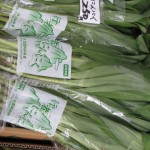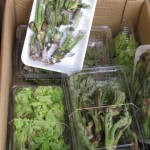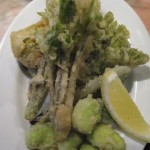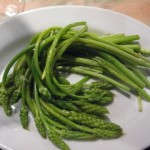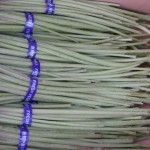What I have always longed for at the beginning of every spring when I was growing up in Tokyo were the delicious varieties of wild mountain vegetables, called sansai. Spring sansai have pleasant astringency and bitterness which was the reason for my craving. Every spring when my mother served us sansei dishes she repeated the story of benefit of eating bitter tasting spring sansai:
It is good for our body because it cleanses toxins that have accumulated in our body during the cold winter time. In Japan we have a saying, “Ryoyaku wa kuchi ni nigashi -Bitter medicine cures our sickness. My mother’s interpretation of “bitter is good” must have come from her life experiences as the daughter of pediatric physician and the wife of surgeon and family doctor.
Most representative spring sansai in Japan are taranome (a bud of a shrub about 2-inches long; my father harvested them and brought them back home from his yearly solo visit to his doctor-friend’s house deep in the country of Gunma Prefecture; tempura is the best method of preparation for this tender bud), fukinoto (a tiny, light green colored bud which shoots out from the ground at the very beginning of spring; distinctive flavor and pleasant bitterness; great for tempura and simmered dishes), kogomi (resembles fiddlehead fern) and takenoko (tender young bamboo shoot; delicious either simmered or grilled).
Now I am in Tokyo in mid-May and had an unexpected encounter with these spring delicacies when we stopped and had a light, delightful dinner at one of our favorites spots – VAPEUR – a casual French/Italian themed stand-bar near Shimbashi Station in central Tokyo. Here are three delicious sansei dishes we enjoyed: sansai no furitto (Italian fritto-style deep-fried assorted Japanese wild vegetables), asuparagasu sobaju (sautéed asperge sauvage – wild asparagus imported from France) and takenoko to asari (simmered bamboo shoot and asari clams). Among these delicious dishes asperge sauvage was something that I have never tasted before even in France. Quickly cooked wild asparagus in olive oil and garlic was crispy, and at the same time its texture reminded me somehow of okra’s slight sliminess. Why I have not yet seen this unique vegetable variety in New York City where world famous chefs are continuously competing with each other to introduce new dishes to their diners may be because of the distinctive texture characteristics of this vegetable. Asperge sauvage is said to be found in the south and Loire areas of France (based on my web search). Look for it on your next trip to those regions in spring, or, strangely enough, at VAPEUR in Tokyo.

